engine coolant FIAT IDEA 2007 1.G Owners Manual
[x] Cancel search | Manufacturer: FIAT, Model Year: 2007, Model line: IDEA, Model: FIAT IDEA 2007 1.GPages: 314, PDF Size: 4.78 MB
Page 25 of 314
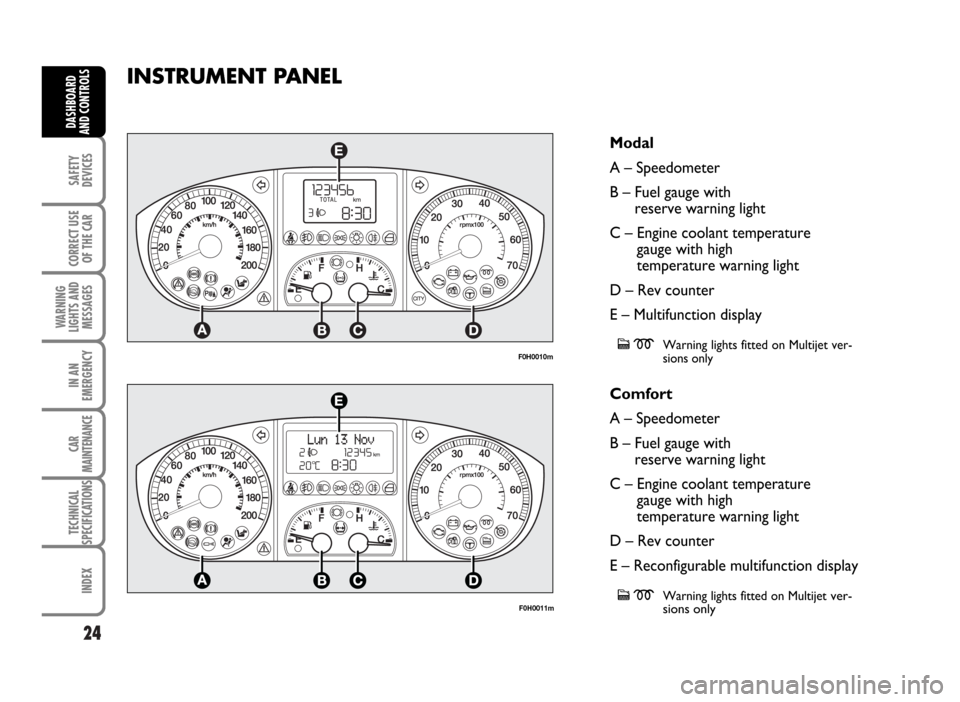
24
SAFETY
DEVICES
CORRECT USE
OF THE CAR
WARNING
LIGHTS AND
MESSAGES
IN AN
EMERGENCY
CAR
MAINTENANCE
TECHNICAL
SPECIFICATIONS
INDEX
DASHBOARD
AND CONTROLS
F0H0010m
F0H0011m
Modal
A – Speedometer
B – Fuel gauge with
reserve warning light
C – Engine coolant temperature
gauge with high
temperature warning light
D – Rev counter
E – Multifunction display
cmWarning lights fitted on Multijet ver-
sions only
Comfort
A – Speedometer
B – Fuel gauge with
reserve warning light
C – Engine coolant temperature
gauge with high
temperature warning light
D – Rev counter
E – Reconfigurable multifunction display
cmWarning lights fitted on Multijetver-
sions only
INSTRUMENT PANEL
Page 27 of 314
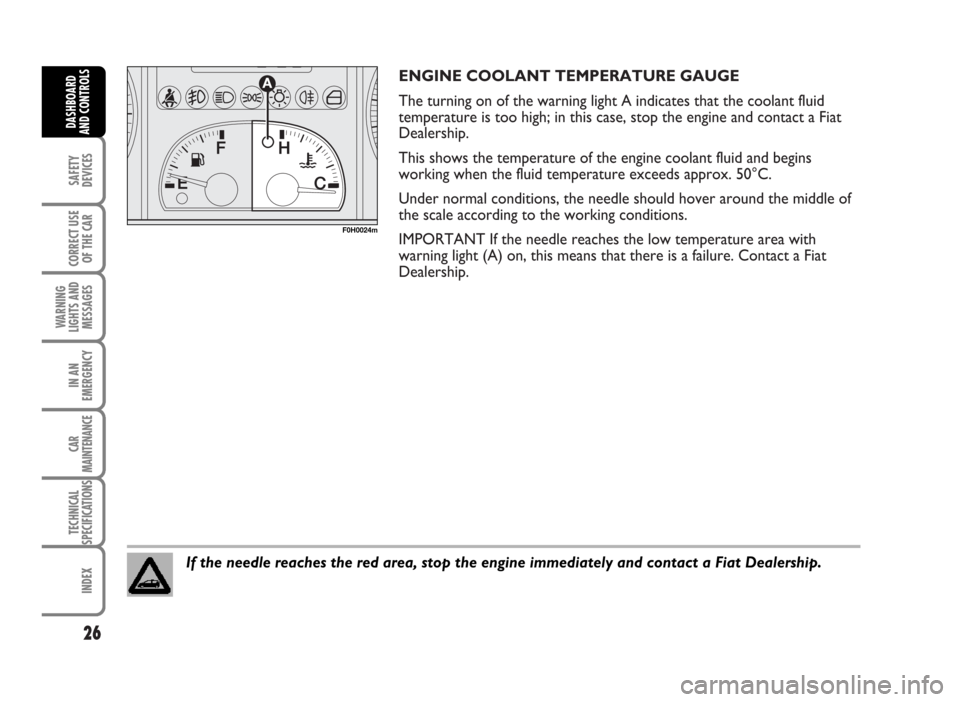
ENGINE COOLANT TEMPERATURE GAUGE
The turning on of the warning light A indicates that the coolant fluid
temperature is too high; in this case, stop the engine and contact a Fiat
Dealership.
This shows the temperature of the engine coolant fluid and begins
working when the fluid temperature exceeds approx. 50°C.
Under normal conditions, the needle should hover around the middle of
the scale according to the working conditions.
IMPORTANT If the needle reaches the low temperature area with
warning light (A) on, this means that there is a failure. Contact a Fiat
Dealership.
26
SAFETY
DEVICES
CORRECT USE
OF THE CAR
WARNING
LIGHTS AND
MESSAGES
IN AN
EMERGENCY
CAR
MAINTENANCE
TECHNICAL
SPECIFICATIONS
INDEX
DASHBOARD
AND CONTROLS
F0H0024m
If the needle reaches the red area, stop the engine immediately and contact a Fiat Dealership.
Page 99 of 314
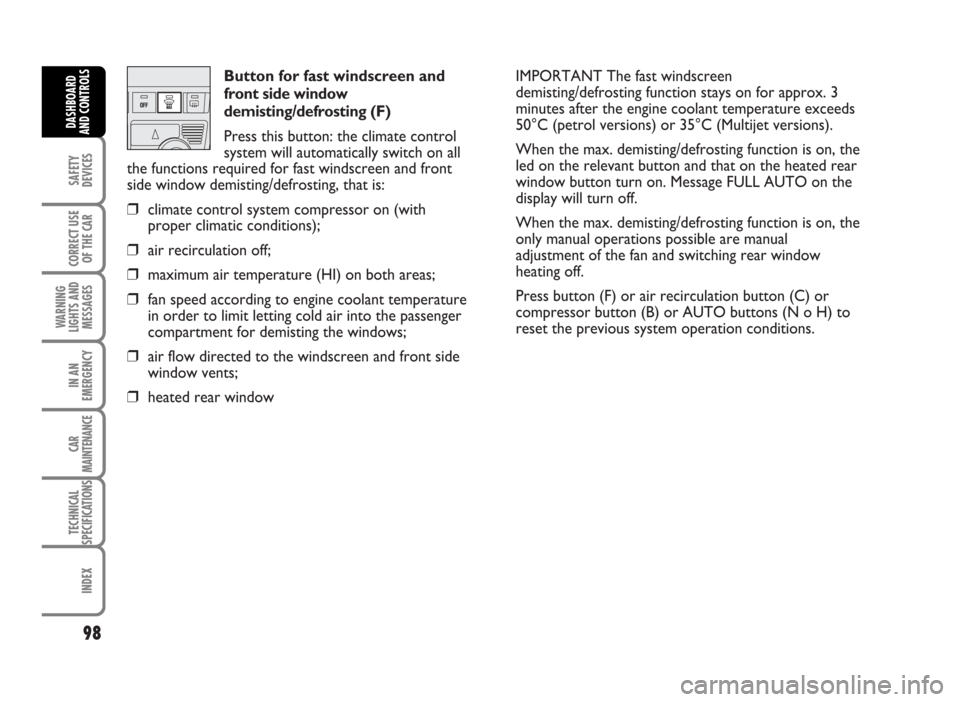
Button for fast windscreen and
front side window
demisting/defrosting (F)
Press this button: the climate control
system will automatically switch on all
the functions required for fast windscreen and front
side window demisting/defrosting, that is:
❒climate control system compressor on (with
proper climatic conditions);
❒air recirculation off;
❒maximum air temperature (HI) on both areas;
❒fan speed according to engine coolant temperature
in order to limit letting cold air into the passenger
compartment for demisting the windows;
❒air flow directed to the windscreen and front side
window vents;
❒heated rear windowIMPORTANT The fast windscreen
demisting/defrosting function stays on for approx. 3
minutes after the engine coolant temperature exceeds
50°C (petrol versions) or 35°C (Multijet versions).
When the max. demisting/defrosting function is on, the
led on the relevant button and that on the heated rear
window button turn on. Message FULL AUTO on the
display will turn off.
When the max. demisting/defrosting function is on, the
only manual operations possible are manual
adjustment of the fan and switching rear window
heating off.
Press button (F) or air recirculation button (C) or
compressor button (B) or AUTO buttons (N o H) to
reset the previous system operation conditions.
98
SAFETY
DEVICES
CORRECT USE
OF THE CAR
WARNING
LIGHTS AND
MESSAGES
IN AN
EMERGENCY
CAR
MAINTENANCE
TECHNICAL
SPECIFICATIONS
INDEX
DASHBOARD
AND CONTROLS
Page 181 of 314
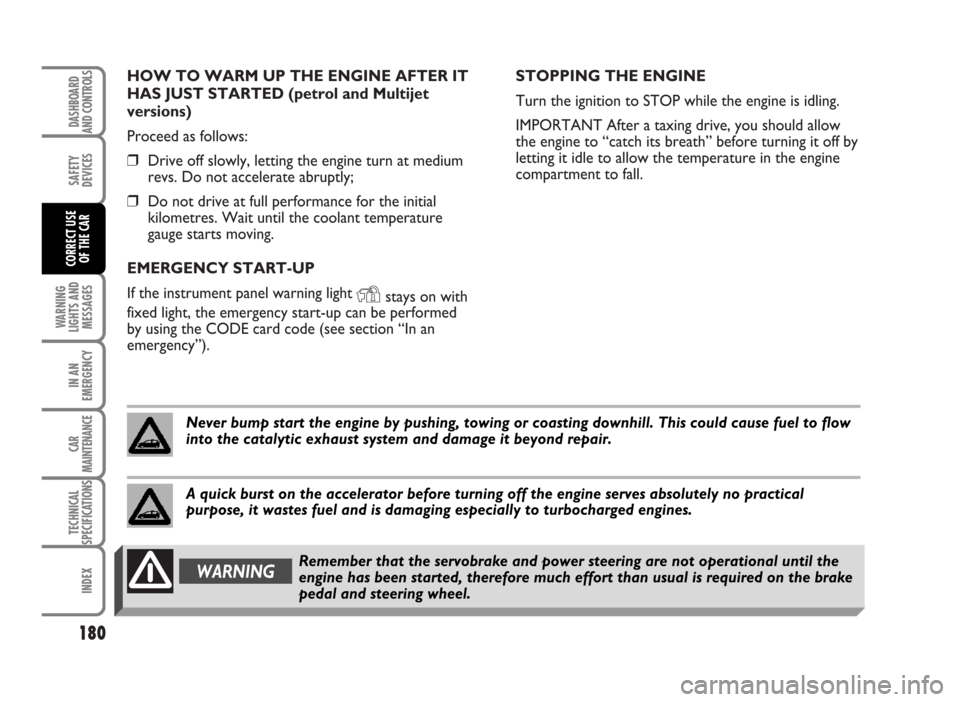
HOW TO WARM UP THE ENGINE AFTER IT
HAS JUST STARTED (petrol and Multijet
versions)
Proceed as follows:
❒Drive off slowly, letting the engine turn at medium
revs. Do not accelerate abruptly;
❒Do not drive at full performance for the initial
kilometres. Wait until the coolant temperature
gauge starts moving.
EMERGENCY START-UP
If the instrument panel warning light
Ystays on with
fixed light, the emergency start-up can be performed
by using the CODE card code (see section “In an
emergency”).STOPPING THE ENGINE
Turn the ignition to STOP while the engine is idling.
IMPORTANT After a taxing drive, you should allow
the engine to “catch its breath” before turning it off by
letting it idle to allow the temperature in the engine
compartment to fall.
180
SAFETY
DEVICES
WARNING
LIGHTS AND
MESSAGES
IN AN
EMERGENCY
CAR
MAINTENANCE
TECHNICAL
SPECIFICATIONS
INDEX
DASHBOARD
AND CONTROLS
CORRECT USE
OF THE CAR
Never bump start the engine by pushing, towing or coasting downhill. This could cause fuel to flow
into the catalytic exhaust system and damage it beyond repair.
A quick burst on the accelerator before turning off the engine serves absolutely no practical
purpose, it wastes fuel and is damaging especially to turbocharged engines.
Remember that the servobrake and power steering are not operational until the
engine has been started, therefore much effort than usual is required on the brake
pedal and steering wheel.WARNING
Page 192 of 314
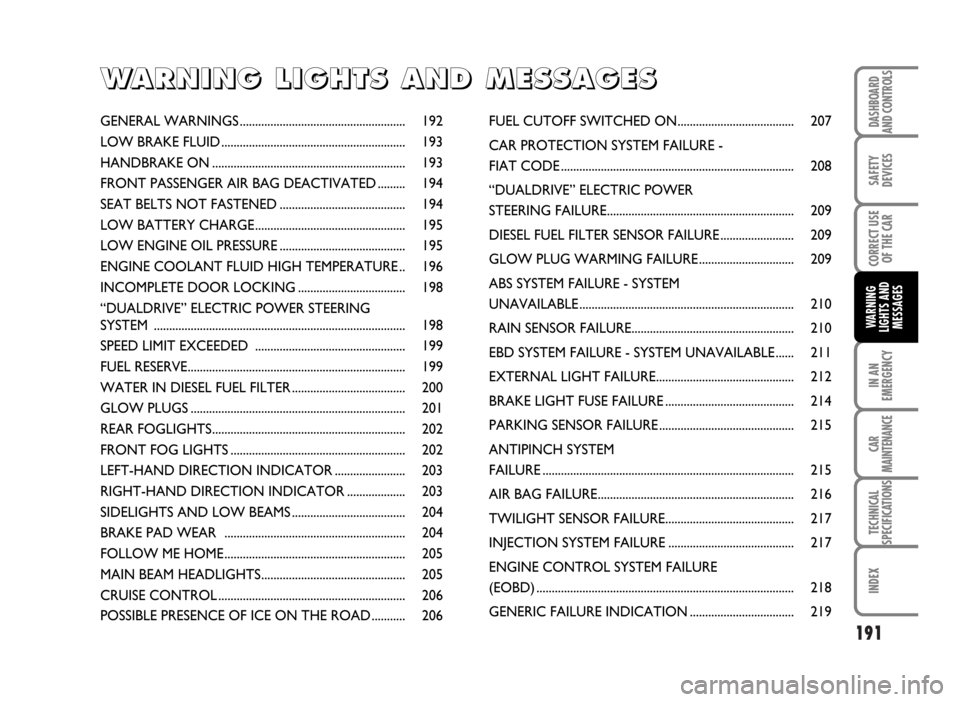
191
SAFETY
DEVICES
CORRECT USE
OF THE CAR
IN AN
EMERGENCY
CAR
MAINTENANCE
TECHNICAL
SPECIFICATIONS
INDEX
DASHBOARD
AND CONTROLS
WARNING
LIGHTS AND
MESSAGES
W W
A A
R R
N N
I I
N N
G G
L L
I I
G G
H H
T T
S S
A A
N N
D D
M M
E E
S S
S S
A A
G G
E E
S S
FUEL CUTOFF SWITCHED ON...................................... 207
CAR PROTECTION SYSTEM FAILURE -
FIAT CODE ............................................................................ 208
“DUALDRIVE” ELECTRIC POWER
STEERING FAILURE............................................................. 209
DIESEL FUEL FILTER SENSOR FAILURE ........................ 209
GLOW PLUG WARMING FAILURE ............................... 209
ABS SYSTEM FAILURE - SYSTEM
UNAVAILABLE ...................................................................... 210
RAIN SENSOR FAILURE..................................................... 210
EBD SYSTEM FAILURE - SYSTEM UNAVAILABLE ...... 211
EXTERNAL LIGHT FAILURE............................................. 212
BRAKE LIGHT FUSE FAILURE .......................................... 214
PARKING SENSOR FAILURE ............................................ 215
ANTIPINCH SYSTEM
FAILURE .................................................................................. 215
AIR BAG FAILURE................................................................ 216
TWILIGHT SENSOR FAILURE.......................................... 217
INJECTION SYSTEM FAILURE ......................................... 217
ENGINE CONTROL SYSTEM FAILURE
(EOBD) .................................................................................... 218
GENERIC FAILURE INDICATION .................................. 219 GENERAL WARNINGS ...................................................... 192
LOW BRAKE FLUID ............................................................ 193
HANDBRAKE ON ............................................................... 193
FRONT PASSENGER AIR BAG DEACTIVATED ......... 194
SEAT BELTS NOT FASTENED ......................................... 194
LOW BATTERY CHARGE................................................. 195
LOW ENGINE OIL PRESSURE ......................................... 195
ENGINE COOLANT FLUID HIGH TEMPERATURE .. 196
INCOMPLETE DOOR LOCKING ................................... 198
“DUALDRIVE” ELECTRIC POWER STEERING
SYSTEM .................................................................................. 198
SPEED LIMIT EXCEEDED ................................................. 199
FUEL RESERVE....................................................................... 199
WATER IN DIESEL FUEL FILTER ..................................... 200
GLOW PLUGS ...................................................................... 201
REAR FOGLIGHTS............................................................... 202
FRONT FOG LIGHTS ......................................................... 202
LEFT-HAND DIRECTION INDICATOR ....................... 203
RIGHT-HAND DIRECTION INDICATOR ................... 203
SIDELIGHTS AND LOW BEAMS ..................................... 204
BRAKE PAD WEAR ........................................................... 204
FOLLOW ME HOME ........................................................... 205
MAIN BEAM HEADLIGHTS............................................... 205
CRUISE CONTROL ............................................................. 206
POSSIBLE PRESENCE OF ICE ON THE ROAD ........... 206
Page 197 of 314

196
SAFETY
DEVICES
CORRECT USE
OF THE CAR
IN AN
EMERGENCY
CAR
MAINTENANCE
TECHNICAL
SPECIFICATIONS
INDEX
DASHBOARD
AND CONTROLS
WARNING
LIGHTS AND
MESSAGES
ENGINE COOLANT FLUID HIGH
TEMPERATURE
Turning the ignition key to MAR the warning
light on the dial turns on, but it should go off
after few seconds.
The warning light turns on (on certain versions
together with the message on the display) when
the engine is overheated. If the warning light
comes on when driving, proceed as follows:
❒normal driving conditions: stop the car,
switch off the engine and check whether the
water level in the reservoir is not below the
MIN mark. Otherwise wait for few seconds
to allow engine cooling, then open slowly and
carefully the cap, top up coolant and check
whether its level is falling between MIN and
MAX marks in the reservoir. Check visually
any leak. If when restarting the warning light
comes on again, contact a Fiat Dealership;
ç
continues on next page
red
Warning
light on dialMessage on reconfigurable
multifunction displayMessage on
multifunction display
Page 198 of 314

197
SAFETY
DEVICES
CORRECT USE
OF THE CAR
IN AN
EMERGENCY
CAR
MAINTENANCE
TECHNICAL
SPECIFICATIONS
INDEX
DASHBOARD
AND CONTROLS
WARNING
LIGHTS AND
MESSAGES
❒car heavy duty(e.g.: towing trailer uphill or
fully laden car): decrease speed, if the warning
light stays on, stop the car. Wait for 2 or 3
minutes leaving the engine on and slightly
accelerated to further activate the circulation
of the coolant fluid, then switch the engine off.
Check proper coolant level as described
previously.
IMPORTANT Under severe use of the car, keep
the engine on and slightly accelerated for few
minutes before switching it off.ç
continued from previous page
red
Warning
light on dial Message on
multifunction displayMessage on reconfigurable
multifunction display
Page 262 of 314
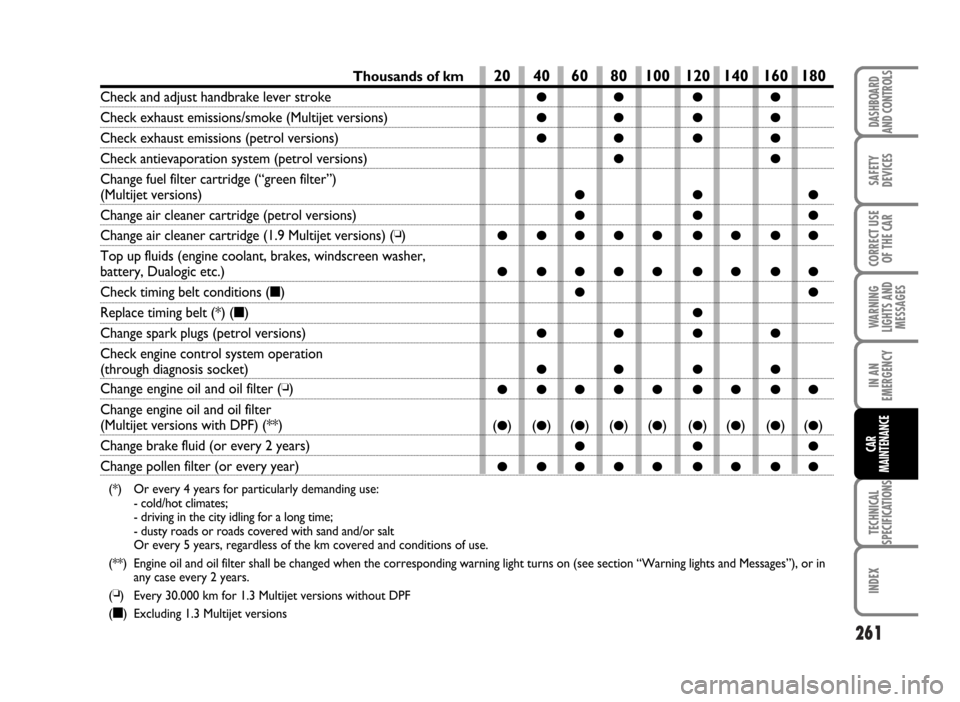
261
SAFETY
DEVICES
CORRECT USE
OF THE CAR
WARNING
LIGHTS AND
MESSAGES
IN AN
EMERGENCY
TECHNICAL
SPECIFICATIONS
INDEX
DASHBOARD
AND CONTROLS
CAR
MAINTENANCE
Thousands of km
Check and adjust handbrake lever stroke
Check exhaust emissions/smoke (Multijet versions)
Check exhaust emissions (petrol versions)
Check antievaporation system (petrol versions)
Change fuel filter cartridge (“green filter”)
(Multijet versions)
Change air cleaner cartridge (petrol versions)
Change air cleaner cartridge (1.9 Multijet versions) (❏)
Top up fluids (engine coolant, brakes, windscreen washer,
battery, Dualogic etc.)
Check timing belt conditions (■)
Replace timing belt (*) (■)
Change spark plugs (petrol versions)
Check engine control system operation
(through diagnosis socket)
Change engine oil and oil filter (❏)
Change engine oil and oil filter
(Multijet versions with DPF) (**)
Change brake fluid (or every 2 years)
Change pollen filter (or every year)
(*) Or every 4 years for particularly demanding use:
- cold/hot climates;
- driving in the city idling for a long time;
- dusty roads or roads covered with sand and/or salt
Or every 5 years, regardless of the km covered and conditions of use.
(**) Engine oil and oil filter shall be changed when the corresponding warning light turns on (see section “Warning lights and Messages”), or in
any case every 2 years.
(
❏) Every 30.000 km for 1.3 Multijet versions without DPF
(
■) Excluding 1.3 Multijet versions
20 40 60 80 100 120 140 160 180
●● ● ●
●● ● ●
●● ● ●
●●
●●●
●●●
●●●●● ●●●●
●●●●● ●●●●
●●
●
●● ● ●
●● ● ●
●●●●● ●●●●
(●)(●)(●)(●)(●)(●)(●)(●)(●)
●●●
●●●●● ●●●●
Page 263 of 314
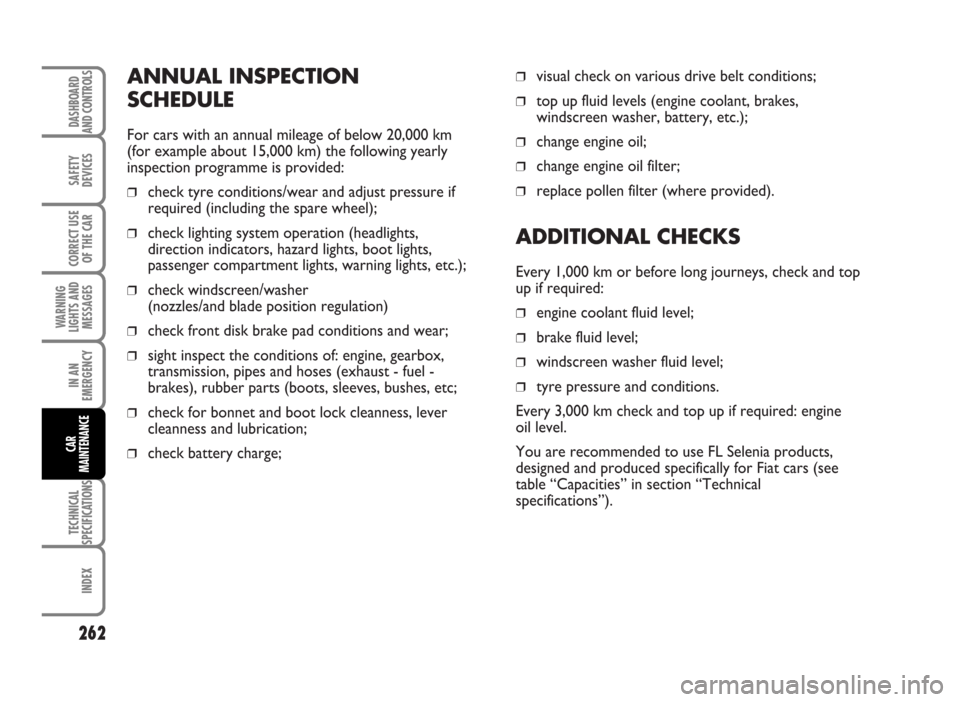
ANNUAL INSPECTION
SCHEDULE
For cars with an annual mileage of below 20,000 km
(for example about 15,000 km) the following yearly
inspection programme is provided:
❒check tyre conditions/wear and adjust pressure if
required (including the spare wheel);
❒check lighting system operation (headlights,
direction indicators, hazard lights, boot lights,
passenger compartment lights, warning lights, etc.);
❒check windscreen/washer
(nozzles/and blade position regulation)
❒check front disk brake pad conditions and wear;
❒sight inspect the conditions of: engine, gearbox,
transmission, pipes and hoses (exhaust - fuel -
brakes), rubber parts (boots, sleeves, bushes, etc;
❒check for bonnet and boot lock cleanness, lever
cleanness and lubrication;
❒check battery charge;
❒visual check on various drive belt conditions;
❒top up fluid levels (engine coolant, brakes,
windscreen washer, battery, etc.);
❒change engine oil;
❒change engine oil filter;
❒replace pollen filter (where provided).
ADDITIONAL CHECKS
Every 1,000 km or before long journeys, check and top
up if required:
❒engine coolant fluid level;
❒brake fluid level;
❒windscreen washer fluid level;
❒tyre pressure and conditions.
Every 3,000 km check and top up if required: engine
oil level.
You are recommended to use FL Selenia products,
designed and produced specifically for Fiat cars (see
table “Capacities” in section “Technical
specifications”).
262
SAFETY
DEVICES
CORRECT USE
OF THE CAR
WARNING
LIGHTS AND
MESSAGES
IN AN
EMERGENCY
TECHNICAL
SPECIFICATIONS
INDEX
DASHBOARD
AND CONTROLS
CAR
MAINTENANCE
Page 266 of 314
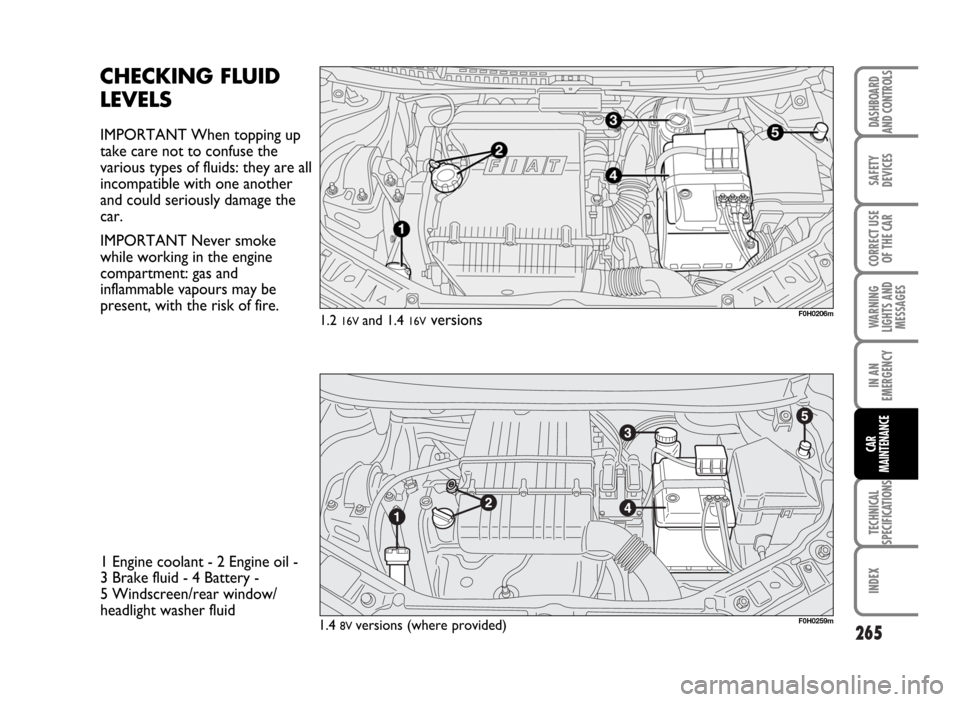
265
SAFETY
DEVICES
CORRECT USE
OF THE CAR
WARNING
LIGHTS AND
MESSAGES
IN AN
EMERGENCY
TECHNICAL
SPECIFICATIONS
INDEX
DASHBOARD
AND CONTROLS
CAR
MAINTENANCE
CHECKING FLUID
LEVELS
IMPORTANT When topping up
take care not to confuse the
various types of fluids: they are all
incompatible with one another
and could seriously damage the
car.
IMPORTANT Never smoke
while working in the engine
compartment: gas and
inflammable vapours may be
present, with the risk of fire.
1 Engine coolant - 2 Engine oil -
3 Brake fluid - 4 Battery -
5 Windscreen/rear window/
headlight washer fluid
F0H0206m1.2 16V and 1.4 16Vversions
F0H0259m1.4 8V versions (where provided)